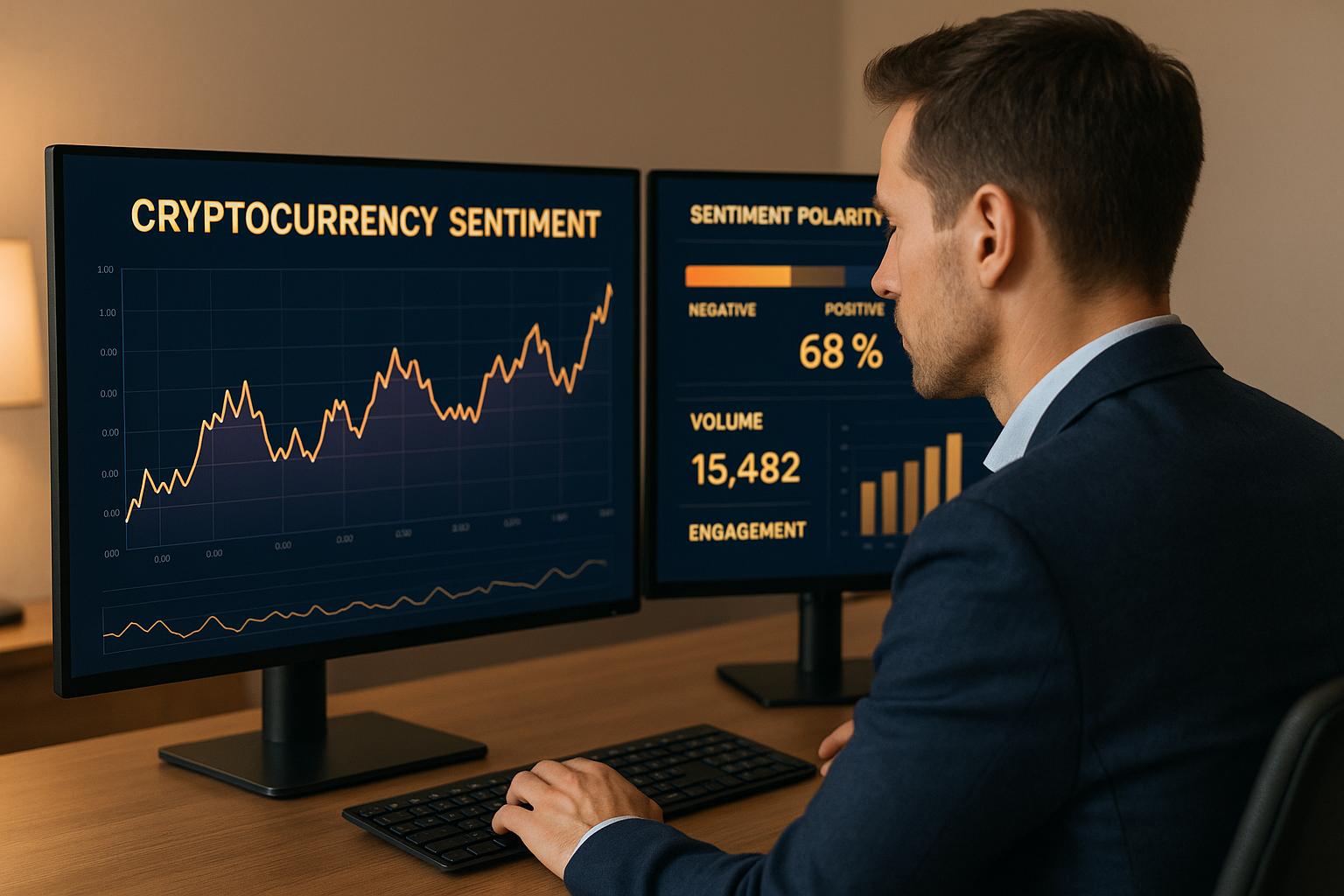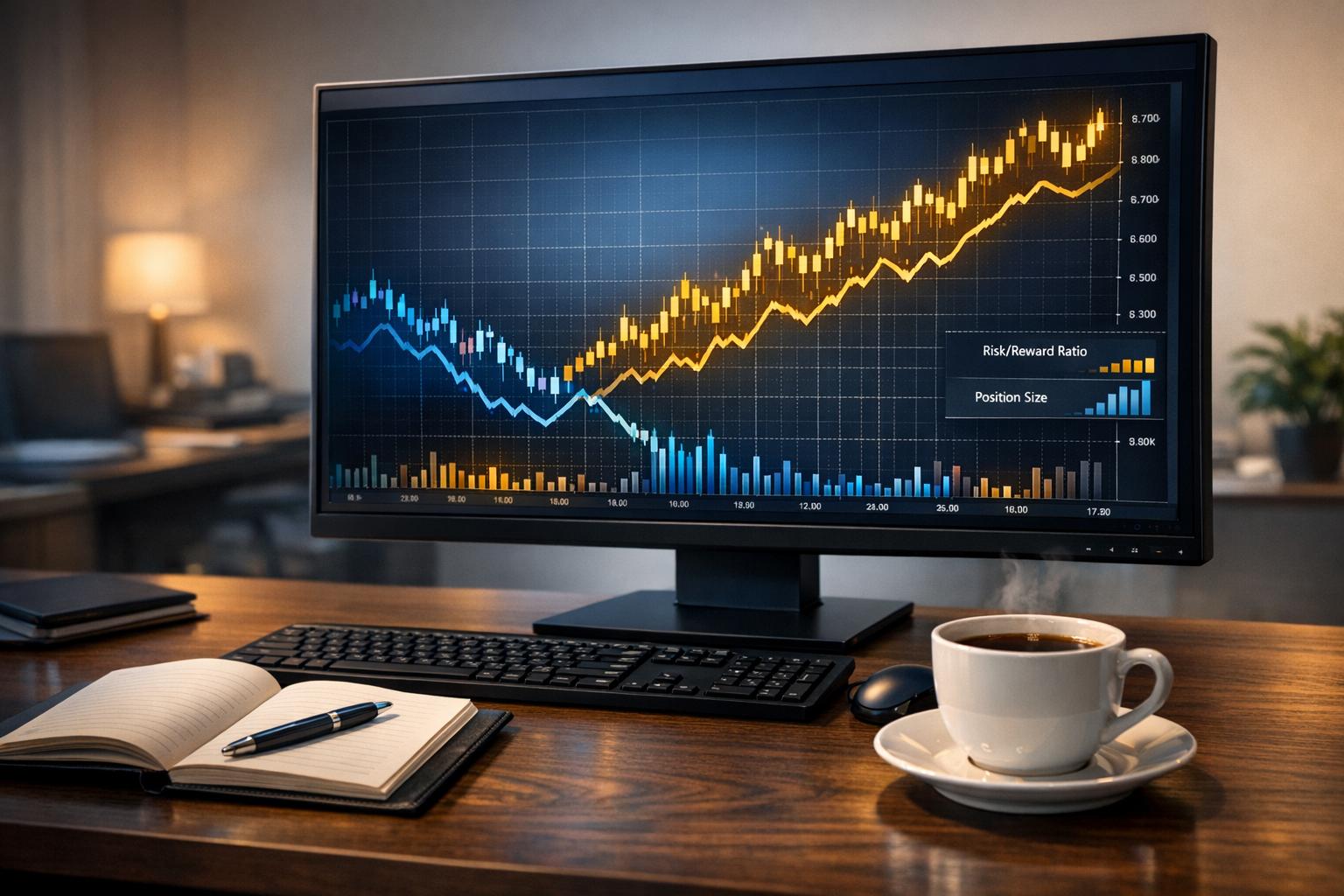AI sentiment analysis is reshaping cryptocurrency trading by offering real-time insights from social media, forums, and market data. This technology helps traders predict price movements faster and with more precision than traditional methods. Key metrics like sentiment polarity scores, volume of mentions, and emotion classification provide actionable signals for BUY, SELL, and HOLD decisions. Platforms like StockioAI integrate these metrics with technical analysis, achieving a reported 75% win rate in volatile crypto markets.
Key Takeaways:
- Sentiment Polarity Scores: Measure market mood (positive, negative, neutral).
- Volume of Mentions: Tracks how often a crypto is discussed, signaling trends.
- Emotion Classification: Identifies fear, greed, and optimism to anticipate market moves.
- Engagement Metrics: Analyzes likes, retweets, and shares to gauge influence.
- Market Regime Classification: Aligns sentiment with market conditions (trending, volatile, ranging).
How To Use AI For Market Sentiment Analysis? - CryptoBasics360.com

Primary Data Sources for Sentiment Analysis
Grasping these data sources is essential for understanding the metrics that follow. AI-driven sentiment analysis relies on three main streams of data to anticipate price movements. Together, these sources provide traders with a cohesive and actionable view of the market.
Social Media Platforms
Twitter/X offers real-time insights into how the market reacts to developments. Its immediacy makes it a critical tool for detecting sentiment shifts that often precede price changes. AI tools analyze not only the content of tweets but also engagement metrics to assess market momentum [2][4].
TikTok brings a visual dimension to sentiment analysis by capturing tone, expressions, and imagery. A study combining Twitter’s text-based sentiment with TikTok’s video-based sentiment revealed that TikTok signals often drive short-term market momentum, while Twitter sentiment aligns more with longer-term trends. This multimodal approach improved forecasting accuracy by 20% [4].
TradingView contributes sentiment data by tracking active contributors, social volume, and sentiment percentages. It also measures unique user interactions and total mentions within a 24-hour window, offering a snapshot of market engagement [5].
While social media captures quick reactions, forums provide a space for more in-depth discussions.
Crypto Forums and News Outlets
Platforms like Reddit and Bitcointalk host detailed conversations that can reveal market-moving events and investor sentiment. These forums allow AI systems to identify nuanced opinions and emerging trends that may not surface in the fast-paced world of social media [6].
Major crypto news outlets, such as CoinDesk and The Block, play a crucial role by reporting on regulatory updates, project developments, and security incidents that influence sentiment. For instance, StockioAI’s Market News Feed integrates these updates with real-time data to provide a comprehensive view of the market [1].
Market Data Feeds
Price, volume, and liquidity data serve as the backbone of sentiment analysis, linking emotional signals to actual trading behaviors. Platforms like CoinGecko monitor over 500 exchanges and 13,000 digital assets, offering a broad spectrum of market data [7].
On-chain data from tools like Glassnode and CryptoQuant adds another layer, revealing behavioral patterns that complement sentiment insights. Additionally, correlating trading volume with sentiment helps differentiate genuine market interest from artificial hype. For example, a surge in positive Twitter sentiment combined with rising trading volume often indicates authentic market activity. Conversely, sentiment spikes without matching volume may point to false positives [2][6][8].
In one case study, researchers analyzed S-Score sentiment metrics from Twitter for 865 cryptocurrencies. They found that coins with the most positive sentiment delivered 191.52% cumulative returns over 21 months, compared to just 35.33% for coins with negative sentiment [2].
Core Metrics in AI Sentiment Analysis
Using established data sources, these metrics simplify complex signals into actionable trading insights. By analyzing raw social media and news data, they provide traders with clear indicators to guide their strategies.
Sentiment Polarity Scores
Sentiment polarity scores evaluate whether the sentiment around a cryptocurrency is positive, negative, or neutral. These scores typically range from 0 to 100, with numbers close to 50 reflecting neutrality, while higher or lower values indicate strong bullish or bearish sentiment.
One notable example is the S-Score metric developed by Context Analytics. This metric standardizes sentiment over a 24-hour period and compares it against a rolling baseline. A study analyzing 865 cryptocurrencies found that tokens with the highest positive sentiment delivered 191.52% returns over 21 months, compared to just 35.33% for those with negative sentiment [2]. Such outcomes highlight how polarity scores can provide valuable insights into short-term price movements.
Platforms like StockioAI incorporate sentiment analysis into their trading algorithms, processing over 60 data points every second. By combining sentiment polarity with technical indicators, StockioAI generates precise BUY, SELL, and HOLD signals, achieving an impressive 75% win rate in volatile crypto markets [1].
Volume of Mentions
The Volume of Mentions tracks how often a cryptocurrency is discussed across social media, forums, and news outlets within a given timeframe. A sudden surge in mentions often signals emerging narratives that can lead to price volatility.
A related metric, social dominance percentage, measures a cryptocurrency's share of mentions compared to others, helping traders spot trending assets early. For example, in August 2023, LunarCrush recorded over 120,000 tweets about Bitcoin within 48 hours following a major ETF approval announcement. This spike in mentions was followed by a 7% price increase, with Bitcoin's Galaxy Score jumping from 65 to 92 [5]. Such patterns underscore the importance of tracking mention volume for early trend detection.
Emotion and Tone Classification
Advanced AI tools go beyond basic sentiment analysis to classify content based on emotions like fear, greed, optimism, and uncertainty. This deeper layer of analysis helps traders understand the emotional drivers behind market movements.
For instance, language reflecting fear often signals panic selling, while expressions of greed or excitement can point to speculative bubbles. By quantifying these emotions, traders can anticipate market reactions and adjust their risk strategies. For example, during periods of fear, traders might tighten stop-loss levels or reduce their positions. On the other hand, waves of optimism could present opportunities to ride bullish momentum before it peaks.
Platforms like StockioAI integrate this emotional analysis into their broader trading strategies, enabling users to respond quickly to shifting market sentiment.
Engagement Metrics
Engagement metrics measure how widely sentiment spreads through actions like likes, retweets, comments, and shares. High engagement levels indicate that a sentiment-driven narrative has significant influence on market participants.
For example, a tweet about a cryptocurrency that garners thousands of retweets and likes is likely to have a stronger market impact compared to one with minimal interaction. By analyzing these metrics, traders can gauge the potential reach and influence of sentiment-driven trends.
Market Regime Classification
Market regime classification uses AI to identify current market conditions - whether trending, ranging, or volatile - providing essential context for interpreting sentiment data. This classification helps traders align their strategies with the prevailing market environment.
For instance, in a trending market, positive sentiment can reinforce existing momentum, while in volatile conditions, it might signal a potential reversal. StockioAI's market regime classification combines social media trends with market data to generate precise trading strategies, including entry points, stop-loss levels, and profit targets [1].
| Market Regime | Sentiment Impact | Trading Approach |
|---|---|---|
| Trending | Reinforces momentum | Follow sentiment direction |
| Volatile | May signal reversal | Take a contrarian approach |
| Ranging | Limited impact | Combine with technical analysis |
Using Sentiment Metrics in Trading Strategies
Profitable trading often hinges on combining real-time sentiment signals with technical analysis. Traders who incorporate sentiment metrics into their strategies can better adapt to shifting market conditions while managing risk effectively. This approach uses real-time data to complement technical analysis, offering a more informed basis for trade validation.
Using Real-Time Trading Signals
Real-time sentiment analysis transforms vast streams of social media and news data into actionable BUY, SELL, and HOLD signals. By identifying shifts in market mood, these signals can often predict price movements before they appear on traditional charts, giving traders a competitive edge.
Take StockioAI as an example. The platform processes 60 data points every second, blending sentiment polarity scores with technical indicators to deliver precise trading signals. According to StockioAI, this method has yielded a 75% win rate and a 2.95 Profit Factor across 35 closed trades, showcasing the potential of sentiment-driven strategies in volatile crypto markets [1].
Some of the most important metrics for real-time signals include:
- Sentiment polarity scores to gauge overall market mood.
- Volume of mentions to identify trending narratives.
- Engagement metrics to estimate the reach and influence of sentiment-driven movements.
For instance, in June 2025, a surge in positive sentiment around Solana helped traders anticipate its price rise above $140, allowing them to position early before the broader market caught on [3].
Combining Sentiment with Technical Analysis
Sentiment metrics are powerful, but their effectiveness increases when paired with technical indicators. Combining these tools helps validate sentiment signals and reduces the likelihood of false positives. For example, a spike in bullish sentiment confirmed by a positive crossover on the MACD provides stronger confidence in a BUY signal. Similarly, an RSI reading above 70 paired with negative sentiment might indicate an upcoming price correction.
StockioAI excels in this integrated approach by combining sentiment insights with interactive charts. These charts display AI-generated trading levels, support and resistance zones, and traditional technical indicators. The platform’s machine learning algorithms also identify chart patterns and trend reversals, which traders can cross-check with sentiment data to fine-tune entry and exit points [1].
Interestingly, multimodal sentiment analysis - where multiple data sources are used - has been shown to improve forecasting accuracy by up to 20% [4]. Advanced traders often take this a step further by validating sentiment signals with on-chain metrics like exchange inflows and NVT ratios. This ensures decisions are grounded in a broader, multi-dimensional analysis rather than sentiment alone [3].
Risk Management and Historical Sentiment Analysis
While real-time signals guide immediate trades, historical sentiment data plays a critical role in shaping risk management strategies. Patterns in historical sentiment often precede significant price movements, offering valuable insights. For example, extreme sentiment readings - whether highly positive or negative - can signal potential reversals. Traders can use this information to adjust position sizes or tighten stop-loss levels.
Risk management tools that integrate both real-time and historical sentiment data provide additional safeguards. StockioAI's Risk Calculator, for instance, uses AI to simulate various market scenarios. This helps traders determine appropriate stop-loss levels, position sizes, and portfolio allocations based on current and projected sentiment trends [1].
"StockioAI revolutionized my trading strategy. The AI insights helped me achieve consistent 18% monthly returns."
– Jordan Martinez, Quantitative Trader [1]
In practice, traders monitor both present sentiment conditions and historical trends. During periods of extreme fear, for example, they might reduce leverage and increase cash holdings. Conversely, historically bullish sentiment patterns can signal emerging opportunities - all while adhering to a disciplined risk management framework.
Machine learning tools have also demonstrated the ability to predict daily price movements for specific cryptocurrencies by analyzing real-time tweet sentiment and volume. These tools often provide confidence scores, giving traders additional assurance in their decisions [9]. By blending historical patterns with real-time data, traders can build a robust framework for identifying opportunities and mitigating risks.
Conclusion
AI-driven sentiment analysis is playing a pivotal role in transforming how crypto trading strategies are developed, offering traders the ability to make more informed decisions. The metrics we've discussed - such as sentiment polarity scores, volume of mentions, emotion and tone analysis, engagement metrics, and market regime classification - serve as essential tools for understanding market sentiment and predicting price trends.
These metrics do more than just measure market mood; they actively inform trading strategies. Historical data shows that assets with a positive sentiment often yield better performance compared to those with negative sentiment, proving that sentiment metrics can directly influence trading outcomes [2].
Platforms like StockioAI showcase how sentiment analysis can be seamlessly integrated with technical analysis and risk management tools. By combining these elements, StockioAI creates a comprehensive trading environment that enables traders to navigate the unpredictable crypto market with greater accuracy and control. This blending of sentiment insights with technical data represents a forward-thinking approach to cryptocurrency trading.
The evidence is clear: leveraging multiple data points - whether it's tracking social dominance, analyzing engagement trends, or studying historical sentiment - provides the most reliable market insights. The key to success lies in applying these tools within a structured, data-driven strategy to make smarter, more disciplined trading decisions.
FAQs
How does AI sentiment analysis improve cryptocurrency trading predictions?
AI-driven sentiment analysis is transforming cryptocurrency trading by analyzing massive datasets - think news articles, social media chatter, and market trends - to uncover patterns and gauge market sentiment. Unlike traditional methods that depend on historical data or time-consuming manual reviews, AI processes real-time information at lightning speed, offering sharper and more timely insights.
Using sophisticated algorithms, tools like StockioAI deliver actionable recommendations such as BUY, SELL, or HOLD signals. These insights help traders make smarter, data-backed decisions while minimizing the pitfalls of emotional trading - a crucial advantage in the fast-moving world of cryptocurrency.
How do social media platforms like Twitter and TikTok influence AI sentiment analysis in cryptocurrency markets?
Social media platforms like Twitter and TikTok have become key players in shaping AI-driven sentiment analysis for cryptocurrency markets. These platforms are brimming with real-time user opinions, trending discussions, and insights into market sentiment, making them a goldmine for understanding public attitudes toward specific cryptocurrencies or overall market conditions.
AI algorithms dive into this wealth of data to detect sentiment patterns - whether the chatter leans positive or negative. These insights can be incredibly useful for traders looking to stay ahead of market shifts. By keeping a close eye on social media trends, traders can gain a clearer picture of potential market movements and make decisions with greater confidence.
How can traders use sentiment polarity scores and mention volume to enhance their trading strategies?
Sentiment polarity scores and mention volume are powerful tools for understanding market trends and trader sentiment. Polarity scores reflect the general tone of market conversations - whether they're leaning positive or negative - giving traders a snapshot of public opinion on specific cryptocurrencies. Meanwhile, mention volume tracks how often a cryptocurrency is being discussed, which can highlight growing interest or heightened concerns.
To use these metrics effectively, traders can look for patterns where spikes in mention volume align with shifts in sentiment polarity. For instance, a sharp rise in positive sentiment combined with increased mentions might signal growing enthusiasm for a cryptocurrency, potentially indicating a buying opportunity. On the other hand, high mention volumes paired with negative sentiment could point to a possible downturn. By pairing these insights with technical analysis and risk management strategies, traders can make better-informed decisions. Platforms like StockioAI make this process easier by delivering real-time sentiment analysis and actionable trading signals, helping traders navigate the unpredictable crypto market.




